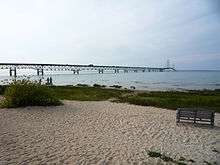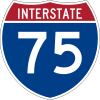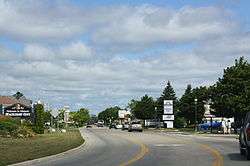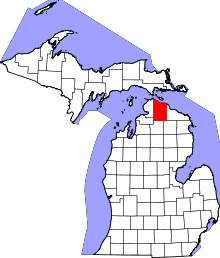Mackinaw City, Michigan
| Mackinaw City, Michigan | ||
|---|---|---|
| Village | ||
| Village of Mackinaw City | ||
|
Mackinaw City Hotel District | ||
| ||
 Location of Mackinaw City within Michigan | ||
| Coordinates: 45°47′02″N 84°43′40″W / 45.78389°N 84.72778°WCoordinates: 45°47′02″N 84°43′40″W / 45.78389°N 84.72778°W | ||
| Country | United States | |
| State | Michigan | |
| Counties | Emmet, Cheboygan | |
| Townships | Mackinaw, Wawatam | |
| Village | 1857 | |
| Government | ||
| • Village President | Jeff Hingston | |
| Area[1] | ||
| • Total | 7.60 sq mi (19.68 km2) | |
| • Land | 3.38 sq mi (8.75 km2) | |
| • Water | 4.22 sq mi (10.93 km2) | |
| Elevation | 594 ft (181 m) | |
| Population (2010)[2] | ||
| • Total | 806 | |
| • Estimate (2012[3]) | 807 | |
| • Density | 238.5/sq mi (92.1/km2) | |
| Time zone | EST (UTC-5) | |
| • Summer (DST) | EDT (UTC-4) | |
| ZIP code | 49701 | |
| Area code(s) | 231 | |
| FIPS code | 26-50320[4] | |
| GNIS feature ID | 1620662[5] | |
| Website | http://www.mackinawcity.org/ | |
Mackinaw City /ˈmækᵻnɔː ˈsɪti/ is a village in Emmet and Cheboygan counties in the U.S. state of Michigan. The population was 806 at the 2010 census; the population surges during the summer tourist season, including an influx of tourists and seasonal workers who serve in the shops, hotels and other recreational facilities there and in the surrounding region. Mackinaw City is at the northern tip (headland) of the Michigan's Lower Peninsula along the southern shore of the Straits of Mackinac. Across the straits lies the state's Upper Peninsula. These two land masses are physically connected by the Mackinac Bridge, which runs from Mackinaw City north to St. Ignace. Mackinaw City is also the primary base for ferry service to Mackinac Island, located to the northeast in the straits.
According to AAA's 2009 TripTik requests, Mackinaw City is the most popular tourist city in the state of Michigan.[6] Local attractions include Fort Michilimackinac, the Mackinac Bridge, the Mackinaw Crossings shopping mall, Mill Creek, the Old Mackinac Point Light, the Historic Village, the McGulpin Point Light, and the retired US Coast Guard Icebreaker Mackinaw.
The official name of the community is "The Village of Mackinaw City" and as that suggests, it is a village by state law. Mackinaw City is governed by the General Law Village Act, Public Act No. 3, of 1895, as amended.[7] The downtown district and much of the development lie within Mackinaw Township, Cheboygan County, but the larger portion of the village by area is in Wawatam Township, Emmet County, which borders Mackinaw Township to the west.
History
The predominant historic tribes in this area were three Algonquian peoples, known collectively as the Council of Three Fires: Chippewa (Ojibwe in Canada), Ottawa (Odawa), and Potawatomi at the time of French contact in the 17th century. Although not having permanent settlements according to European thinking, these tribes had long frequented the area of the Straits to fish, hunt, trade, and worship. Mackinac Island in the straits appeared to have the shape of a turtle. The Native Americans here had a creation myth based on the sacred turtle. The Straits of Mackinac was the center of two routes vital to the fur trade: one to Montreal in the east, by way of Lake Nipissing and the Ottawa River valley; and the other to Detroit in the south via Lakes Huron and St. Clair.
European exploration and Fort Michilimackinac
The first European to pass the site of Mackinaw City was Jean Nicolet, sent out from Quebec City by Samuel Champlain in 1633 to explore and map the western Great Lakes, and to establish new contacts and trading partnerships with the Indian tribes of the region.[8] His reports resulted in the French government providing funds to send settlers, missionaries, traders, and soldiers to the Great Lakes region. Father Jacques Marquette had established a mission on Mackinac Island in 1671 (which was shortly thereafter moved to St. Ignace on the Michigan peninsula, where it remained active until 1705). The construction of Fort de Baude at St. Ignace in 1681 was an attempt by the authorities of New France to establish a military presence at the Straits, but it closed in 1697.[9]
Mackinaw City's first European settlement came in 1715 when the French built Fort Michilimackinac. They lost it to the British during the Seven Years' War, and the British abandoned the fort in 1783, after the American Revolutionary War resulted in independence of its Thirteen Colonies. The site of the fort in present-day Mackinaw City is a National Historic Landmark and is now preserved as an open-air historical museum. As with the forts at other settlements of the era and region such as Detroit, Michilimackinac was a fairly small post. It housed French civilians inside the fort, and allowed them to garden, hunt, and fish outside the walls. It was a trading post for the fur trade.
At the end of the French and Indian War (1754–1763), the British took possession of the fort, but continued to allow the French civilians to live within the walls, as they had good relations with the Odawa and Ojibwe for the fur trade. As a part of Pontiac's Rebellion, Chippewa and Fox warriors captured the fort on June 2, 1763 in a surprise attack during a game of baggatiway or lacrosse; the British at the fort were taken prisoner and mostly killed.
Europeans, in the form of French and Scots-Irish traders from Detroit and elsewhere, did not return until the following spring, with the understanding that they would trade more fairly with the Native Americans. The British abandoned the vulnerable site on the mainland during the American Revolutionary War; from 1779 to 1781, the troops moved the fort, including its buildings, to Mackinac Island, where they established Fort Mackinac. What the British did not take with them, they burned; that way they could prevent the American rebels from using Michilimackinac as a base.
Mackinaw City from mid-19th century to present
In 1857, two men by the names of Conkling and Searles platted what would become Mackinaw City. The original plan reserved the northern portion as a park, to preserve the area that was once Fort Michilimackinac and to accommodate a hoped-for lighthouse. This was not built for nearly a generation after the land was set aside.
The village became a vital port for train ferries crossing the Straits beginning in the 1890s, and later, for ferries for automobiles. Auto ferries ran from the early 1900s to 1957, ending after the completion of the Mackinac Bridge. Train ferries crossed the Straits until 1984. Mackinaw City remains an important port city for tourists traveling by passenger ferry boat to Mackinac Island using the Arnold, Shepler's, and Star Line services.
Old Mackinac Point Lighthouse was built in 1892 in the same northern park that was originally allotted for its construction. This lighthouse would eventually replace McGulpin Point Light, which was built in the 1870s in the far western end of the village limits. When the Mackinac Bridge was completed in 1957, the Old Mackinac Point Lighthouse was decommissioned immediately thereafter. At the same time, a grant was provided to the Mackinac Island State Park Commission, which owned the property at the Bridge's southern terminus, to begin archeological excavations of the Michilimackinac ruins. Ultimately, a reconstruction of the fort to its 1770s appearance would be constructed.[10]
Through the course of time, the main industry of Mackinaw City became almost strictly tourist-oriented, with other major sources of employment being civic services such as mail, police, firefighting, schooling, and so on. Camping, which began in Michilimackinac State Park in 1907, was halted in 1971 as a Maritime Park was opened in 1972 around the lighthouse. This park was shut down in 1990, but Old Mackinac Point Lighthouse was opened to the public in 2004. Mill Creek State Park, which includes the area believed to be where Mill Creek's sawmill once flourished when Mackinac Island was being settled, is located about five miles (8 km) southeast of the village along U.S. Highway 23 (US 23).
Transportation

Highways
 I-75 is a major north-south freeway running the length of the state. From the Ohio border just north of Toledo, it proceeds northerly via Monroe, Detroit, Flint, Saginaw and Grayling, crosses the Mackinac Bridge after passing through the village and continues on to the Upper Peninsula and Sault Ste. Marie.
I-75 is a major north-south freeway running the length of the state. From the Ohio border just north of Toledo, it proceeds northerly via Monroe, Detroit, Flint, Saginaw and Grayling, crosses the Mackinac Bridge after passing through the village and continues on to the Upper Peninsula and Sault Ste. Marie. US 23 has its northern terminus in the village. It is designated as the "Sunrise Side Coastal Highway", and follows the Lake Huron shoreline to the south.
US 23 has its northern terminus in the village. It is designated as the "Sunrise Side Coastal Highway", and follows the Lake Huron shoreline to the south. US 31ends at I-75 four miles (6.4 km) south of the village, continuing southerly toward Traverse City and Muskegon.
US 31ends at I-75 four miles (6.4 km) south of the village, continuing southerly toward Traverse City and Muskegon. M-108 was a short spur route from I-75.
M-108 was a short spur route from I-75. C-81 is a County-Designated Highway running southerly toward Harbor Springs and Petoskey.
C-81 is a County-Designated Highway running southerly toward Harbor Springs and Petoskey.
The Mackinac or Mackinaw Trail is a historically important route to and from the community, both from the north and the south. The trail was long used by the Native American tribes of Michigan. In 1835 it was surveyed between Saginaw and Mackinac by Lieutenant Benjamin Poole of the 3rd U.S. Artillery.[11] (In Saginaw, Mackinaw Street closely follows Poole's route, which continues in the general direction of present-day Midland. Mackinaw Street twists north, becoming Mackinaw Road and following a section line into Bay County.)
Ferry service
Three ferry companies operate out of Mackinaw City, connecting tourists and commuters to Mackinac Island: north and south Arnold Line, Sheplers Ferry and the Star Line.
Bus service
Indian Trails provides daily intercity bus service between St. Ignace and East Lansing, Michigan[12] and between St. Ignace and Bay City, Michigan.[13] Transfer between the lines is possible in Mackinaw City.
Railways
The New York Central's (NYC) Michigan Central subsidiary, the Pennsylvania Railroad's (PRR) Grand Rapids and Indiana Railroad subsidiary, and other rail lines provided passenger traffic on trains such as the Northern Arrow to Mackinaw City. After the NYC and PRR merged to create the Penn Central in 1968, rail traffic diminished and the rail infrastructure deteriorated. The state invested greatly into the failing railways and established the Michigan Northern Railway to operate passenger and freight operations in the early 1980s. Despite sizable patronage, passenger services, as well as freight, operated in the red, prompting the state government to reassess its commitment to operations of the Michigan Northern Railway. All subsidies terminated in 1984, and the lines were sold to CSX Transportation in 1987. It dismantled the tracks shortly thereafter.[14]
The former Michigan Central line to Mackinaw City was improved under the Rails to Trails program. It was rededicated in 2008 as the North Central State Trail, providing a public right-of-way from Mackinaw City to Gaylord, Michigan.
Air
The nearest airports with scheduled passenger service are in Pellston Regional Airport,[15] Traverse City Cherry Capital Airport and Alpena County Regional Airport in the Lower Peninsula and Chippewa County International Airport in Sault Ste. Marie, in the eastern Upper Peninsula.
Geography
- According to the United States Census Bureau, the village has a total area of 7.60 square miles (19.68 km2), of which 3.38 square miles (8.75 km2) is land and 4.22 square miles (10.93 km2) is water.[1]
- Mackinaw City is at the northern extremity of Northern Michigan, which is generally defined as the northern counties of the Lower Peninsula.
Climate
This climatic region has large seasonal temperature differences, with warm to hot (and often humid) summers and cold (sometimes severely cold) winters. According to the Köppen Climate Classification system, Mackinaw City has a humid continental climate, abbreviated "Dfb" on climate maps.[16]
| Climate data for Mackinaw City, Michigan | |||||||||||||
|---|---|---|---|---|---|---|---|---|---|---|---|---|---|
| Month | Jan | Feb | Mar | Apr | May | Jun | Jul | Aug | Sep | Oct | Nov | Dec | Year |
| Average high °C (°F) | −3 (27) |
−1 (31) |
5 (41) |
13 (55) |
20 (68) |
25 (77) |
27 (81) |
26 (79) |
21 (70) |
14 (58) |
7 (44) |
0 (32) |
12.8 (55.3) |
| Average low °C (°F) | −15 (5) |
−15 (5) |
−9 (15) |
−3 (27) |
3 (38) |
8 (47) |
11 (52) |
10 (50) |
6 (42) |
0 (32) |
−4 (24) |
−11 (13) |
−1.6 (29.2) |
| Average precipitation mm (inches) | 46 (1.8) |
33 (1.3) |
53 (2.1) |
58 (2.3) |
64 (2.5) |
84 (3.3) |
86 (3.4) |
97 (3.8) |
89 (3.5) |
61 (2.4) |
56 (2.2) |
48 (1.9) |
775 (30.5) |
| Source: Weatherbase [17] | |||||||||||||
Amenities
Mackinaw City's central shopping district is located along Central Avenue downtown. Many of the shops sell T-shirts, fudge, and toffee. Also located downtown is a small outdoor shopping mall called Mackinaw Crossings, which features a movie theater. As a tourist city, it has more numerous hotels than many other communities.
French Farm Lake, a publicly owned lake maintained for small-boat fishing, is 3 miles southwest.
Demographics
| Historical population | |||
|---|---|---|---|
| Census | Pop. | %± | |
| 1890 | 333 | — | |
| 1900 | 564 | 69.4% | |
| 1910 | 697 | 23.6% | |
| 1920 | 679 | −2.6% | |
| 1930 | 875 | 28.9% | |
| 1940 | 922 | 5.4% | |
| 1950 | 970 | 5.2% | |
| 1960 | 934 | −3.7% | |
| 1970 | 810 | −13.3% | |
| 1980 | 820 | 1.2% | |
| 1990 | 875 | 6.7% | |
| 2000 | 859 | −1.8% | |
| 2010 | 806 | −6.2% | |
| Est. 2014 | 808 | [18] | 0.2% |
2010 census
As of the census[2] of 2010, there were 806 people, 413 households, and 206 families residing in the village. The population density was 238.5 inhabitants per square mile (92.1/km2). There were 814 housing units at an average density of 240.8 per square mile (93.0/km2). The racial makeup of the village was 87.8% White, 5.3% African American, 4.3% Native American, 0.1% from other races, and 2.4% from two or more races. Hispanic or Latino of any race were 2.4% of the population.
There were 413 households of which 18.6% had children under the age of 18 living with them, 39.2% were married couples living together, 7.3% had a female householder with no husband present, 3.4% had a male householder with no wife present, and 50.1% were non-families. 41.9% of all households were made up of individuals and 19.1% had someone living alone who was 65 years of age or older. The average household size was 1.95 and the average family size was 2.62.
The median age in the village was 49.5 years. 16.5% of residents were under the age of 18; 4.1% were between the ages of 18 and 24; 23.5% were from 25 to 44; 31.1% were from 45 to 64; and 24.8% were 65 years of age or older. The gender makeup of the village was 45.2% male and 54.8% female.
2000 census
As of the census[4] of 2000, there were 859 people, 404 households, and 244 families residing in the village. The population density was 255.3 people per square mile (98.7/km²). There were 630 housing units at an average density of 187.3 per square mile (72.4/km²). The racial makeup of the village was 93.02% White, 0.12% African American, 4.54% Native American, 0.12% Asian, and 2.21% from two or more races. Hispanic or Latino of any race were 0.81% of the population.
There were 404 households out of which 21.5% had children under the age of 18 living with them, 48.5% were married couples living together, 9.4% had a female householder with no husband present, and 39.6% were non-families. 34.4% of all households were made up of individuals and 15.8% had someone living alone who was 65 years of age or older. The average household size was 2.12 and the average family size was 2.67.
In the village the population was spread out with 20.6% under the age of 18, 5.0% from 18 to 24, 24.9% from 25 to 44, 30.7% from 45 to 64, and 18.7% who were 65 years of age or older. The median age was 45 years. For every 100 females there were 88.0 males. For every 100 females age 18 and over, there were 86.3 males.
The median income for a household in the village was $37,031, and the median income for a family was $43,125. Males had a median income of $31,771 versus $30,125 for females. The per capita income for the village was $18,725. About 7.5% of families and 9.7% of the population were below the poverty line, including 13.5% of those under age 18 and 2.8% of those age 65 or over.
Education
Mackinaw City Public Schools provides Mackinaw City students with education. There are two schools, the elementary school (K-5) and the high school (6-12).[20]
Village officials
- Village Manager - Adam Smith
- Village President - Jeff Hingston
- Village Clerk - Lana Jaggi
- Village Treasurer - Patty Peppler
- Superintendent of Public Works - Ken Newsome
- Community Development Director -
- Recreation Director/Harbormaster - Dave Paquet
- Police Chief - Pat Wyman
- Water, Wastewater Superintendent - Pat Rivera
- Planning Commission Chair - Rosada Mann
Other affiliations
- It is part of the Roman Catholic Diocese of Gaylord.[21]
- It is part of the Episcopal Diocese of Northern Michigan.[22]
Images
-

Post office
Notes
- 1 2 "US Gazetteer files 2010". United States Census Bureau. Retrieved 2012-11-25.
- 1 2 "American FactFinder". United States Census Bureau. Retrieved 2012-11-25.
- ↑ "Population Estimates". United States Census Bureau. Retrieved 2013-06-03.
- 1 2 "American FactFinder". United States Census Bureau. Retrieved 2008-01-31.
- ↑ "US Board on Geographic Names". United States Geological Survey. 2007-10-25. Retrieved 2008-01-31.
- ↑ Following are: Traverse City, Muskegon, Frankenmuth/Birch Run, Boyne Mountain, Dearborn/The Henry Ford (also known as the Henry Ford Museum and Greenfield Village), Munising, Sault Sainte Marie, Dundee, Saugatuck/Douglas and Lansing. 2009 Memorial Day driving, AAA Michigan Triptik requests.
- ↑ "Government - Village of Mackinaw City". The Village of Mackinaw City. Retrieved 27 April 2013.
- ↑ Fischer, David Hackett. Champlain's Dream (2008) p.503
- ↑ Walter Romig, Michigan Place Names, p. 204
- ↑ "Mackinac State Historic Parks". mackinacparks.com.
- ↑ Poole, Benjamin (1837). Survey of a Road Route from Saginaw to Mackinac (Map). Scale not given. Washington: Benjamin Poole. M.T. 25 Congress 2 Session, Doc. no. 234. Retrieved June 14, 2012 – via Michigan State University Map Library.
- ↑ "EAST LANSING-PETOSKEY-ST. IGNACE" (PDF). Indian Trails. January 15, 2013. Retrieved 2013-02-27.
- ↑ "BAY CITY-ALPENA-CHEBOYGAN-ST. IGNACE" (PDF). Indian Trails. January 15, 2013. Retrieved 2013-02-28.
- ↑ Schwieterman, Joseph P. (2001). When the Railroad Leaves Town: American Communities in the Age of Rail Line Abandonment, Eastern United States. Kirksville, MO: Truman State University Press. pp. 139–143. ISBN 0943549973. OCLC 702179808.
- ↑ "Pellston Regional Airport Serving Northern Michigan Emmet County". pellstonairport.com.
- ↑ "Mackinaw City, Michigan Köppen Climate Classification (Weatherbase)". Weatherbase.
- ↑ "Weatherbase.com". Weatherbase. 2013. Retrieved on August 27, 2013.
- ↑ "Annual Estimates of the Resident Population for Incorporated Places: April 1, 2010 to July 1, 2014". Retrieved June 4, 2015.
- ↑ "Census of Population and Housing". Census.gov. Retrieved June 4, 2015.
- ↑ http://www.mackcity.k12.mi.us/
- ↑ "The Diocese of Gaylord, Michigan : A Diocese of the Roman Catholic Church - Diocese of Gaylord". dioceseofgaylord.org.
- ↑ "Home Page - Episcopal Diocese of Northern Michigan". dioup.org. line feed character in
|title=at position 13 (help)
External links
| Wikimedia Commons has media related to Mackinaw City, Michigan. |
- Mackinaw City at Pure Michigan
- Village of Mackinaw City Municipal Website
- Mackinaw Chamber of Tourism
- Mackinaw area Chamber of Commerce
- Mackinaw City Mi Information
| |||||||||||||||||||||||||||||||||
| |||||||||||||||||||||||||||||||||



